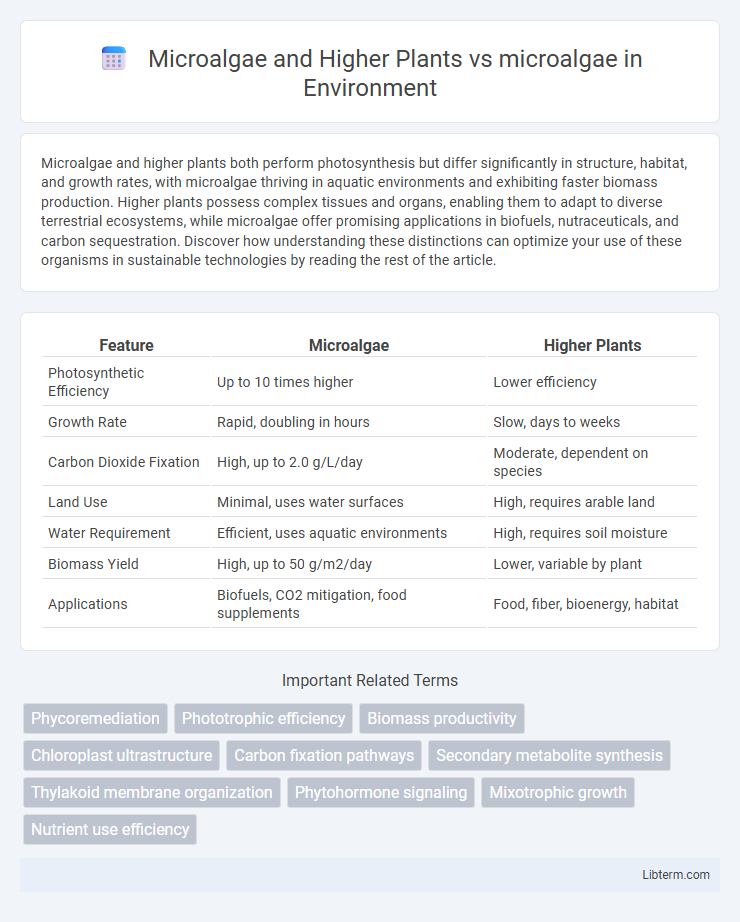Microalgae and higher plants both perform photosynthesis but differ significantly in structure, habitat, and growth rates, with microalgae thriving in aquatic environments and exhibiting faster biomass production. Higher plants possess complex tissues and organs, enabling them to adapt to diverse terrestrial ecosystems, while microalgae offer promising applications in biofuels, nutraceuticals, and carbon sequestration. Discover how understanding these distinctions can optimize your use of these organisms in sustainable technologies by reading the rest of the article.
Table of Comparison
| Feature | Microalgae | Higher Plants |
|---|---|---|
| Photosynthetic Efficiency | Up to 10 times higher | Lower efficiency |
| Growth Rate | Rapid, doubling in hours | Slow, days to weeks |
| Carbon Dioxide Fixation | High, up to 2.0 g/L/day | Moderate, dependent on species |
| Land Use | Minimal, uses water surfaces | High, requires arable land |
| Water Requirement | Efficient, uses aquatic environments | High, requires soil moisture |
| Biomass Yield | High, up to 50 g/m2/day | Lower, variable by plant |
| Applications | Biofuels, CO2 mitigation, food supplements | Food, fiber, bioenergy, habitat |
Introduction to Microalgae and Higher Plants
Microalgae are microscopic photosynthetic organisms that thrive in aquatic environments, exhibiting fast growth rates and high metabolic diversity compared to higher plants. Higher plants, or vascular plants, possess complex structures including roots, stems, and leaves, enabling efficient nutrient transport and support for terrestrial life. Microalgae offer significant biotechnological potential due to their rapid biomass production and ability to synthesize valuable compounds, whereas higher plants contribute extensively to ecosystems through oxygen production, carbon sequestration, and habitat formation.
Biological Characteristics: Microalgae vs Higher Plants
Microalgae exhibit unicellular or simple multicellular structures with high photosynthetic efficiency and rapid growth rates, unlike higher plants which have complex multicellular organization and differentiated tissues such as roots, stems, and leaves. Microalgae thrive in aquatic environments, relying on diverse pigments like chlorophylls, carotenoids, and phycobiliproteins for light absorption, while higher plants primarily use chlorophyll a and b localized in chloroplasts. The ability of microalgae to fix carbon quickly and adapt to varying nutrient conditions contrasts with the slower developmental processes and dependency on soil-based nutrient uptake found in higher plants.
Photosynthetic Efficiency Comparison
Microalgae exhibit significantly higher photosynthetic efficiency compared to higher plants due to their rapid growth rates and ability to utilize a broader spectrum of light wavelengths. The photosynthetic efficiency of microalgae can reach up to 8-10%, whereas higher plants typically achieve 3-6%. This enhanced efficiency stems from microalgae's simpler cellular structure, allowing more effective light capture and carbon fixation in diverse environmental conditions.
Growth Rates and Biomass Production
Microalgae exhibit significantly higher growth rates compared to higher plants, often doubling their biomass in as little as 24 hours under optimal conditions. This rapid proliferation enables microalgae to produce greater biomass per unit area, making them highly efficient for biofuel production and carbon capture. In contrast, higher plants have slower growth cycles, generally requiring weeks to months, limiting their biomass yield over equivalent periods.
Cultivation Methods: Microalgae and Higher Plants
Microalgae cultivation primarily employs photobioreactors and open pond systems, optimizing light exposure and nutrient delivery for rapid biomass production. Higher plants rely on soil-based or hydroponic cultivation, requiring controlled environmental conditions such as temperature, humidity, and soil quality to support growth. Microalgae methods offer higher productivity per unit area and faster growth cycles compared to traditional agricultural techniques used for higher plants.
Environmental Impact and Sustainability
Microalgae demonstrate a significantly lower environmental impact compared to higher plants due to their rapid growth rates and ability to thrive on non-arable land, reducing competition with food crops and minimizing freshwater usage. Their capacity for carbon dioxide sequestration and wastewater bioremediation enhances sustainability by mitigating greenhouse gas emissions and recycling nutrients. While higher plants contribute to biodiversity and ecosystem services, microalgae offer a scalable, resource-efficient solution for sustainable biofuel production and environmental management.
Applications in Food and Nutrition
Microalgae provide a rich source of essential nutrients such as omega-3 fatty acids, proteins, vitamins, and antioxidants, surpassing many higher plants in nutrient density and growth rate. They are increasingly utilized in functional foods, dietary supplements, and as sustainable protein alternatives, addressing global food security and malnutrition challenges. Higher plants contribute traditional carbohydrates, fibers, and phytochemicals, but microalgae's rapid cultivation and high nutritional profile offer innovative solutions for future food and nutrition applications.
Industrial and Pharmaceutical Uses
Microalgae exhibit superior industrial and pharmaceutical potential compared to higher plants due to their rapid growth rates and high biomass productivity, enabling efficient biofuel, bioplastic, and bioactive compound production. Their rich content of essential fatty acids, antioxidants, and unique pigments supports pharmaceutical applications such as anti-inflammatory, antimicrobial, and anticancer agents. Higher plants provide a broader range of secondary metabolites but require more land and time for cultivation, making microalgae a sustainable and scalable alternative for industrial and pharmaceutical sectors.
Challenges and Limitations
Microalgae face challenges such as high production costs, scalability issues, and sensitivity to environmental conditions compared to higher plants that have established agricultural practices and infrastructure. The variability in nutrient requirements and susceptibility to contamination limit large-scale microalgal biomass cultivation, while higher plants benefit from well-understood growth cycles and pest control methods. Despite their rapid growth rates and high lipid content, microalgae require optimized bioreactor designs and advanced harvesting techniques to overcome operational and economic constraints.
Future Perspectives in Biotechnology
Future perspectives in biotechnology showcase microalgae's superior potential over higher plants due to their rapid growth rates, high photosynthetic efficiency, and ability to produce diverse bioactive compounds. Microalgae's scalability in bioreactors and capacity for genetic engineering enable sustainable production of biofuels, pharmaceuticals, and nutraceuticals with lower land and water footprint compared to higher plants. Advances in omics technologies and metabolic pathway optimization further accelerate microalgae's role in addressing global challenges in food security, climate change mitigation, and renewable energy.
Microalgae and Higher Plants Infographic

 libterm.com
libterm.com